Zagreb Mayor Milan Bandić Dead, Heart Attack, Aged 65 Years Old
February 28, 2021 – Zagreb Mayor Milan Bandić has died. At the time of his death, he was the longest-serving capital city mayor in the world and was aged 65 years old.
Zagreb Mayor Milan Bandić has died. At the time of his death, he was the longest-serving capital city mayor in the world. And he was aged 65 years.
News of the death of Zagreb Mayor Milan Bandić was released by official city authorities early in the hours of Sunday 28 February 2021. Zagreb Mayor Milan Bandić © Grad Zagreb
Zagreb Mayor Milan Bandić © Grad Zagreb
Death of Zagreb Mayor Milan Bandić: the city of Zagreb official statement:
“In deep sorrow, we inform our fellow citizens, associates, friends, the Zagreb and Croatian public that suddenly, today, February 28, at the age of 66, the Mayor of the City of Zagreb, Mr. Milan Bandić, died of a heart attack.
He lived for his city, for the people of Zagreb who were in the first place in everything he did, for the job he did with love and energy, bringing in his whole self - without the rest, for 21 years.
We will inform the public about the details, the date of the funeral, the holding of the commemorative gathering, as well as other information related to this sad news.
Rest in peace.”
Croatian media reports that Mr. Bandić fell ill shortly after 11.30pm on Saturday 27 February. It was initially reported that he was at home at the time of falling ill. However, it was later revealed that he had been attended by an ambulance and paramedics at an altogether different address, that of a friend. Shortly thereafter, an ambulance was called to his apartment on Bužanova ulica. Paramedics at the scene attempted to resuscitate Mr. Bandić for 45 minutes before taking him to Sveti Duh hospital, say the media. It would appear that efforts made to revive the mayor were sadly unsuccessful.
He served in the position for 21 years. At the time of his death, Zagreb Mayor Milan Bandić was the longest-serving capital city mayor in the world.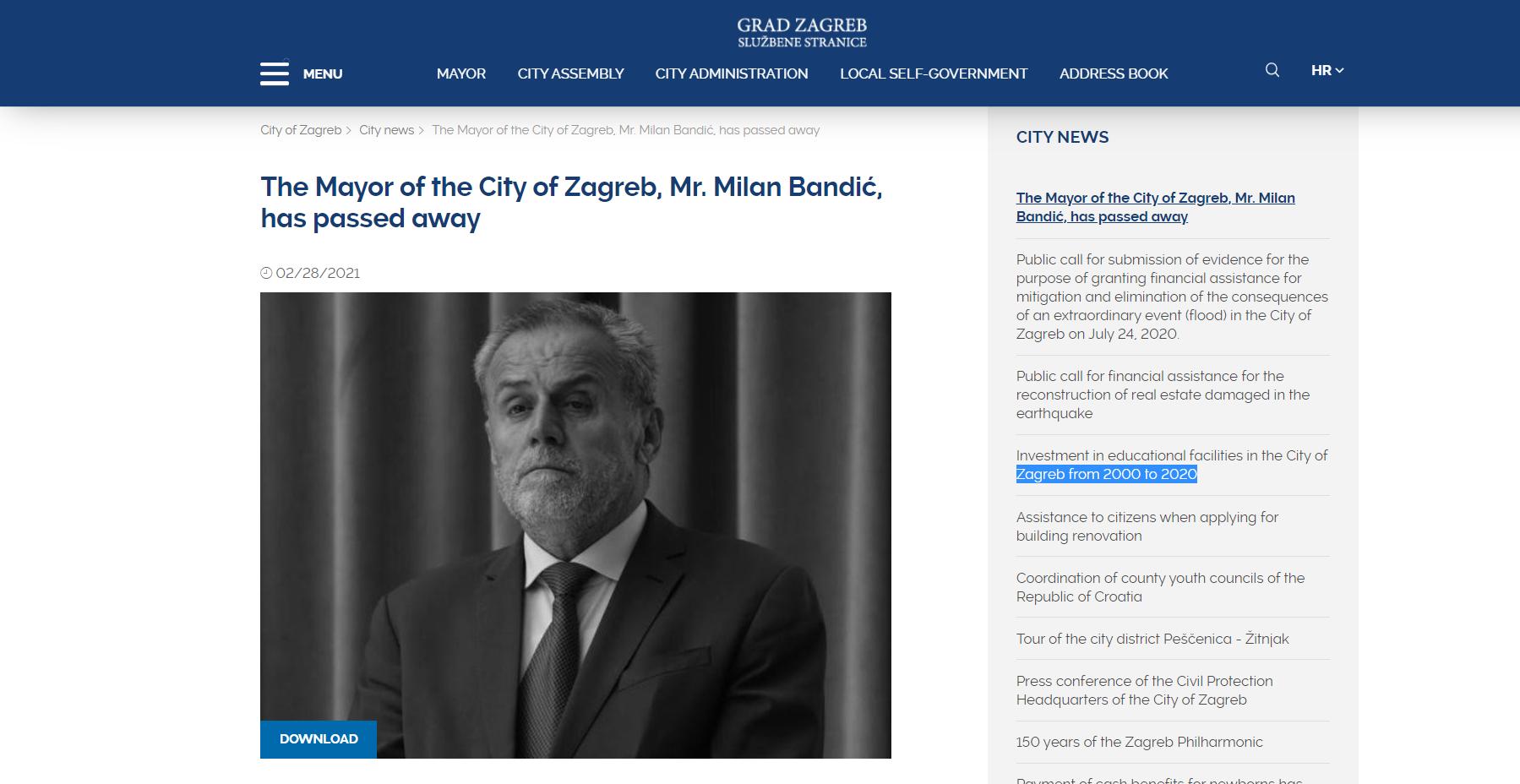 Grad Zagreb screenshot
Grad Zagreb screenshot
Mayor of Zagreb Milan Bandić: his life
Milan Bandić was born 22 November 1955 in the small hamlet of Bandića Brig, a part of Cerov Dolac in the municipality of Grude, Bosnia and Herzegovina. He excelled at athletics in his school years and after graduation, he received a scholarship from the municipality of Grude. This enabled him to go to Zagreb in 1974 to study at university. He enrolled at the Faculty of Political Science (and Journalism).
Over the course of many interviews he gave while in office, Mr. Bandić revealed that in his earliest positions he had worked as an unskilled labourer. However, he was gregarious and a good talker. He improved his employment status by entering local politics.
Following Croatia's independence, there was a change to the structure (and names) of the political entities to which politicians belonged. In 1993, Mr. Bandić became secretary of the SDP City Committee. In 1995, he entered the Zagreb City Assembly as a councilor. Two years later, in 1997, he became president of the Zagreb SDP. In 2000, after securing the largest share of votes, he started his first tenure in the position of mayor of Zagreb.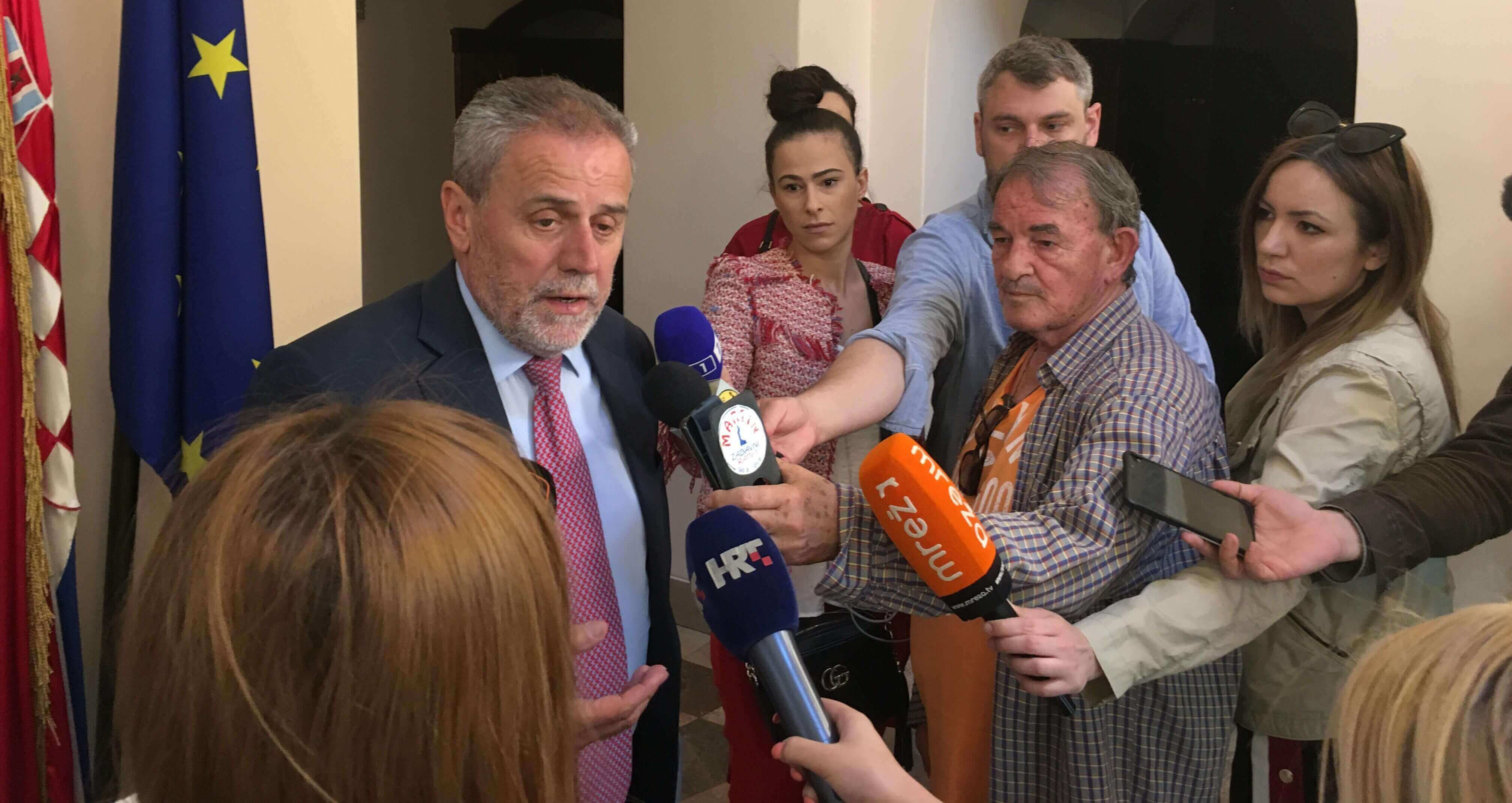 Grad Zagreb
Grad Zagreb
Milan Bandić: tenure as Mayor of Zagreb
As his years in the powerful position continued, Zagreb Mayor Milan Bandić attracted severe criticism from some quarters. He was linked to many scandals and Croatian media estimates that around 250 criminal charges were filed against him. He remained popular enough with segments of Zagreb's population to retain his position in a series of re-elections.
During his tenure as mayor, the city of Zagreb changed considerably. Several new suburbs were built. Housing was provided for a large number of the city's Roma residents. Transport within the city improved. Zagreb became an increasingly more tolerant and safer city. It also became more international.
People from all over the world came to visit the city and Zagreb became Croatia's most popular city destination for tourists (for instance, Zagreb Advent was initiated while Mr. Bandić was in office). Moreover, many internationals moved to live in Zagreb during his tenure, adding to the city's cosmopolitan feel. Many of Mr Bandić's detractors say that improvements in the city occurred in spite of him rather than because of him.
Death of Zagreb Mayor Milan Bandić: consequences
Zagreb mayoral elections are due to take place in 2021. The unexpected death of Mr. Bandić now holds considerable implications for their running and outcome. Many had expected Mr. Bandić to win yet another term. Sections of the Croatian media and political class had offered the opinion that, in some cases, weak candidates were being fielded by specific political parties in opposition to the mayor. Many regarded Mr. Bandić as untoppleable. Others still voiced their opinion that the fielding of weaker candidates was motivated by a desire to maintain the status quo and allow Mr. Bandić to pass without serious obstruction into another term. Such accusations were strenuously denied. As of 21 February 2021, some 12 persons had announced their candidacies for the forthcoming Zagreb mayoral elections. Whatever the outcome of these elections, this year's race will now be missing a candidate ever-present within them for the last two decades.
Mr. Bandic is survived by his wife Vesna who, famously, he married twice, and their daughter Ana Marija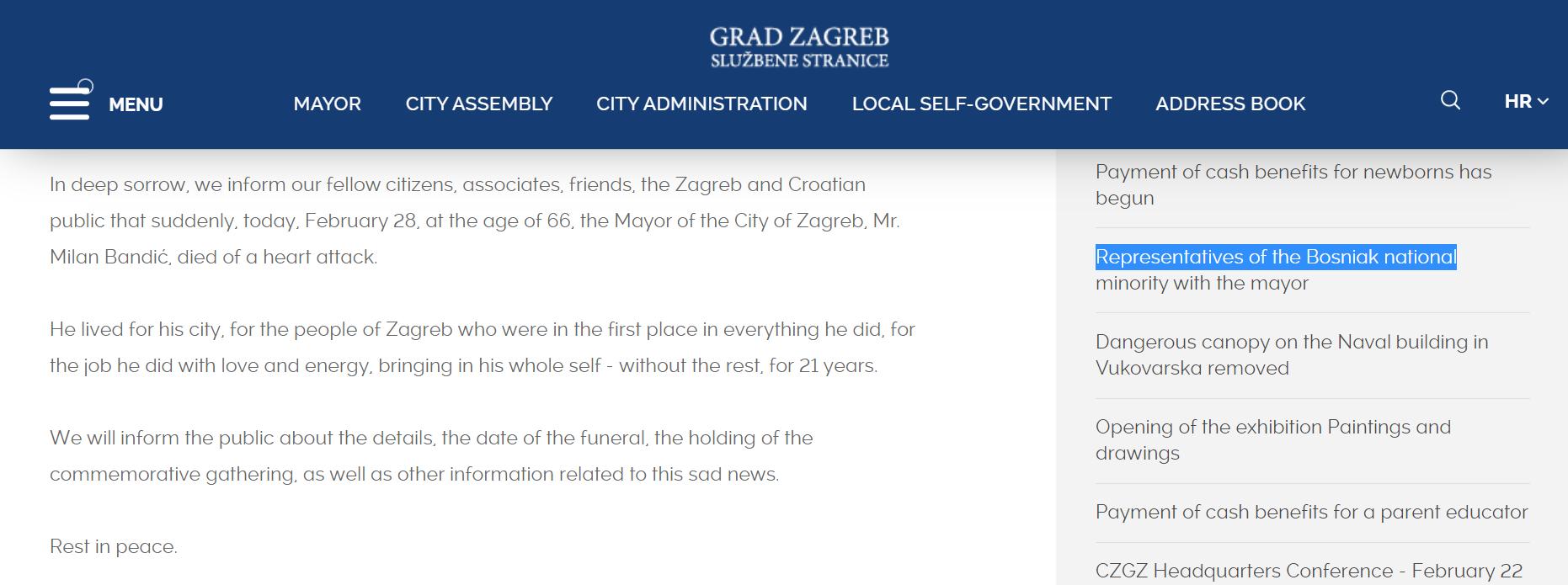 Grad Zagreb screenshot
Grad Zagreb screenshot
For the latest travel info, bookmark our main travel info article, which is updated daily.
Read the Croatian Travel Update in your language - now available in 24 languages.
Join the Total Croatia Travel INFO Viber community.
Zagreb, Karlovac, Sisak Counties Sign Letter of Intent for Common Development
ZAGREB, 26 February, 2021 - Zagreb, Karlovac and Sisak-Moslavina counties have, by signing a letter of intent on Thursday night, shown interest in common development and in that regard, a development agreement is being prepared for signing for about ten projects valued at €50 million and more, the Karlovac County administration said.
On Thursday evening the three county prefects and heads of their development agencies met with Veterans' Affairs Minister Tomo Medved and Minister of Regional Development and EU Funds Nataša Tramišak, and during the meeting it was said that the Regional Development Act enables strategic objectives to be achieved faster through common areas of cooperation and by financing joint projects from EU and national sources.
Tramišak described the development agreement as a "tool to achieve strategic development" and one of the preconditions is to select with the ministry about 10 strategic projects, each with an individual value of €50 million or more, that will require the support of several ministries and guarantee the development of the counties.
Medved offered his full support to the efforts for a joint development agreement between the three counties to be signed because that will enable an equal regional development and broader support from the government and relevant ministries for individual projects.
County prefects Martina Furdek Hajdin, Ivo Žinić and Stjepan Kožić agreed that the problems encountered by all three counties are very similar, from floods to a poor demographic situation and sparsely settled rural areas that cannot compete with developed European regions.
Žinić believes that development would benefit from projects for transport infrastructure and religious, health and conference tourism, while Kožić believes that the urgent repairs in the aftermath of the earthquakes are a priority as that would prevent migration. Kožić also believes that one of the most urgent priorities is broadband Internet.
Furdek Hajdin cited agriculture and tourism as possible projects for cooperation.
"It is up to us how we will prioritise the development of our counties, and European funds will contribute towards achieving the set objectives in the National Development Strategy until 2030. In that regard, the support of the government and its ministries is of exceptional importance," Furdek Hajdin said.
Summer is Coming: Aeroflot Flights to Zagreb, Split, Dubrovnik and Maybe Pula!
February 25, 2021 - Summer is well on its way, with the announcement of Aeroflot flights to Zagreb, Split, Dubrovnik, and maybe Pula!
Croatian Aviation reports that Russian national airline Aeroflot plans to resume traffic to Croatia at the end of April.
Russian airline Aeroflot suspended traffic to Croatia in the spring of 2020 and has not operated on regular flights to Croatian airports since. However, in the summer of 2021, the company plans to return to Croatia, with the announcement of a new route to boot.
The company currently plans to resume traffic on the Moscow-Zagreb-Moscow line from Thursday, March 11, once a week. From Thursday, April 29, daily flights are available between the two cities with A320 aircraft.
Aeroflot previously announced the start of traffic on this route and then postponed it, but this summer there should be a direct airline between the capitals of Moscow and Croatia. Interestingly, Aeroflot resumed traffic to Ljubljana a few days ago and has been operating to Belgrade for a long time.
From June 1, the Moscow-Split-Moscow should be in traffic again, also daily in the summer flight schedule. As in previous years, Aeroflot will use a larger aircraft on this route - A321.
The company plans to re-establish the Moscow-Dubrovnik-Moscow route in the upcoming summer flight schedule, but the schedule has not yet been confirmed and tickets on this route are not yet on sale on the company's official website.
A positive surprise could be a Moscow-Pula-Moscow line, but Pula airport confirmed that negotiations are currently underway and that they hope that Russia's national carrier will decide to establish a line to and from Pula this summer. As soon as the traffic on this line is confirmed and the tickets are on sale, Croatian Aviation will announce the news.
Aeroflot is the national and largest airline in the Russian Federation. The company was founded in 1923, which makes it one of the oldest in the world. According to the announcement from February 1, 2021, the company's fleet consists of as many as 236 aircraft with an average age of only 5.7 years. The fleet consists of:
19 B777,
47 B737,
01 A350,
16 A330,
33 A321,
72 A320,
48 SSJ100.
The company mainly uses A320 and A321 aircraft on the routes to Croatia, while on the route to Zagreb, the Russian SSJ100 is mainly planned in the winter months. In addition to point-to-point passengers, Aeroflot transports a significant number of passengers (mostly tourists) from China, South Korea, and Japan, so the occupancy of aircraft to Croatia will largely depend on passenger restrictions to and from these countries and their ability to travel.
Under normal circumstances, Croatia Airlines operates in the summer flight schedule on the Zagreb-St. Petersburg-Zagreb route. However, this route has not yet been announced by the Croatian national airline for this year's summer flight schedule.
For the latest travel info, bookmark our main travel info article, which is updated daily.
Read the Croatian Travel Update in your language - now available in 24 languages.
VIDEO: 200 Croatian Musicians Perform Unifying Favourite at Bundek
February 23, 2021 – In uplifting scenes filmed on Lake Bundek, Zagreb, 200 Croatian musicians gathered to record a unifying rendition of beloved Croatian hit 'Za ljubav, Treba imat dušu' (For Love, You Need To Have a Soul) by Atomsko Sklonište
It's been 12 months to try and forget. Within a world locked inside by a global pandemic, some in Croatia also became locked out when a series of earthquakes damaged or brought down their family houses. Passing from a state of isolation into one of dreadful uncertainty, it's understandable that some could have been left feeling helpless and alone.
Never ones to be defeated by any crisis, Croatians are well known to pull together when their backs are against the walls. The volunteering effort following Croatia's 2020 earthquakes has offered heartwarming insight into who Croatians are today. In the latest response, 200 Croatian musicians have come together to perform a unifying favourite hit from yesteryear. In the video, the 200 Croatian musicians can be seen playing 'Za ljubav, Treba imat dušu' (For Love, You Need To Have a Soul) by Atomsko Sklonište.
The song chosen for the uplifting effort, '(Za ljubav) Treba imat dušu' was first released in 1982 by Atomsko Sklonište (Atomic Shelter) on their album 'Mentalna Higijena'. Formed in Pula in 1977, the band were popular all over the former Yugoslav federation and became known for performing songs with an anti-war message.
Though the band have undergone a series of lineup changes since the late 1970s, they still perform concerts to this day. Indeed, among the 200 Croatian musicians filmed in the video, we can see Atomsko Sklonište's Bruno Langer playing bass guitar. He has been the bass player of Atomsko Sklonište since they first formed and he leads the band today. Bruno Langer is the writer of '(Za ljubav) Treba imat dušu' which the 200 Croatian musicians play.
The 200 Croatian musicians were comprised of 50 drummers, 50 guitarists, 50 bassists and 50 vocalists. Many are professional musicians who contribute to the contemporary rock and pop scene in Croatia, as well as some well-established performers such as members of Prljavo Kazalište. The 200 Croatian musicians came from across Croatia to volunteer their time for the project, including from Dubrovnik, Pula, Split, Osijek, Rijeka, Požega, Županja, Karlovac, Zagreb and Bjelovar.
For the latest travel info, bookmark our main travel info article, which is updated daily.
Read the Croatian Travel Update in your language - now available in 24 languages.
Flights to Croatia: Austrian Airlines Resumes Traffic to Croatia from End of March
February 19, 2021 - The latest news for flights to Croatia as Austrian Airlines resumes traffic to Croatia from the end of March.
Croatian Aviation reports that from the beginning of its summer flight schedule, Austrian national carrier Austrian Airlines will again operate to three Croatian airports from its base in Vienna; to Dubrovnik, Split, and Zagreb!
A spokeswoman for the airline confirmed the flight schedule for March and April. While the number of weekly flights for the rest of the summer months has not yet been defined, the airline will define the flight schedule for the rest of the summer season in the next two weeks.
With the first day of the summer flight schedule (March 28), Austrian will renew three routes to Zagreb, Split, and Dubrovnik airports.
You can find the confirmed flight schedule below:
Four flights a week to Dubrovnik and Split
The Vienna - Dubrovnik - Vienna line will also start operating from March 28, and in March, it will also operate on Tuesday, March 30.
In the first week of April, two flights have been announced (Thursday and Friday, April 1 and 2); three flights are available in the second week (additionally on Sundays). From the third week of April, the airline will have four flights a week to Dubrovnik, on Tuesdays, Thursdays, Fridays, and Sundays.
By the end of April, Austrian will operate 17 return flights between Dubrovnik and Vienna, using various aircraft types from its fleet (DashQ400, Embraer 195, Airbus 319, and Airbus 320), with A319 aircraft operating on most flights. 4,664 seats are on offer between Dubrovnik and Vienna until the end of April.
The same number of flights, 17 of them, was announced on the Vienna - Split - Vienna route. The company will gradually increase the number of weekly operations, just as in Dubrovnik, offering four flights a week every week from mid-April, also on Tuesdays, Thursdays, Fridays, and Sundays.
Concerning the line to Dubrovnik, larger aircraft (mainly A320) will operate to Split, so the number of offered seats between Split and Vienna is significantly higher than the other two lines to Croatia. A total of 5,400 seats between the two cities are currently available on the market.
It is currently possible to buy tickets for a direct flight to Zadar Airport from May 1. Still, Austrian Airlines has not yet defined its flight schedule from May to September, so it is advised you wait another 10 days when the flight schedule for the peak of the summer season should be confirmed.
The return of Austrian Airlines is important news for the three mentioned Croatian airports. Although this is a smaller number of flights than in 2019, Austrian will offer an enviable number of flights to Croatia in the pre-season given the current situation. Namely, in the stated period of only one month, a total of more than 15 thousand seats are available on the flights of this well-known airline.
For the latest travel info, bookmark our main travel info article, which is updated daily.
Read the Croatian Travel Update in your language - now available in 24 languages.
Split-Barcelona-Split COVID-19 Trip Report, February 11 to 16, 2021
February 17, 2021 - It's been 3 and a half months since I last braved pandemic travel from Croatia to Spain. So, what's changed? My Split-Barcelona-Split COVID-19 trip report, from February 11 to 16, 2021.
At the end of October 2020, I traveled for the first time since the COVID-19 pandemic ravaged Europe. At the time, European countries were still figuring out how to introduce negative PCR tests for entry and defining what entailed being 'high-risk.' This time around, a year deep into the pandemic, it's safe to say most countries have defined requirements that work for them. Furthermore, the information is readily available for travelers online to avoid any mishaps on their journey, which I nearly avoided (more on that later).
Not quite for tourism purposes, I booked my trip to Barcelona to visit my partner who currently plays water polo there. His birthday falls on February 13, conveniently before Valentine's Day, and fortunately, on a weekend when he didn't have any games. Much like my first trip visiting him there, I needed to bring a suitcase of his belongings, which had been sitting in my bedroom since COVID-19 forced him out of Split last March.
Unfortunately, it wasn't much easier getting to Barcelona this time - and thanks to the double whammy of it being the offseason in the middle of a pandemic, not only were ticket prices steep, but the usual two-hour travel time turned into 14-hour travel days from start to finish.
The only available options were on the route from Split-Zagreb-Frankfurt-Barcelona and back, operated by Croatia Airlines and Lufthansa. At least my luggage was included in the ticket price.
I was tested for COVID-19 24-hours before my departure at the Vukovarska testing center in Split. A huge win is that testing prices were halved at the end of January, so instead of paying almost 900 kn for a PCR test and English translation, tests are currently 400 kn and 450 kn with a translation. I was tested at 7:40 am and received my result via email before 5 pm the same day, in English, and with my passport number included (another requirement for Spain).
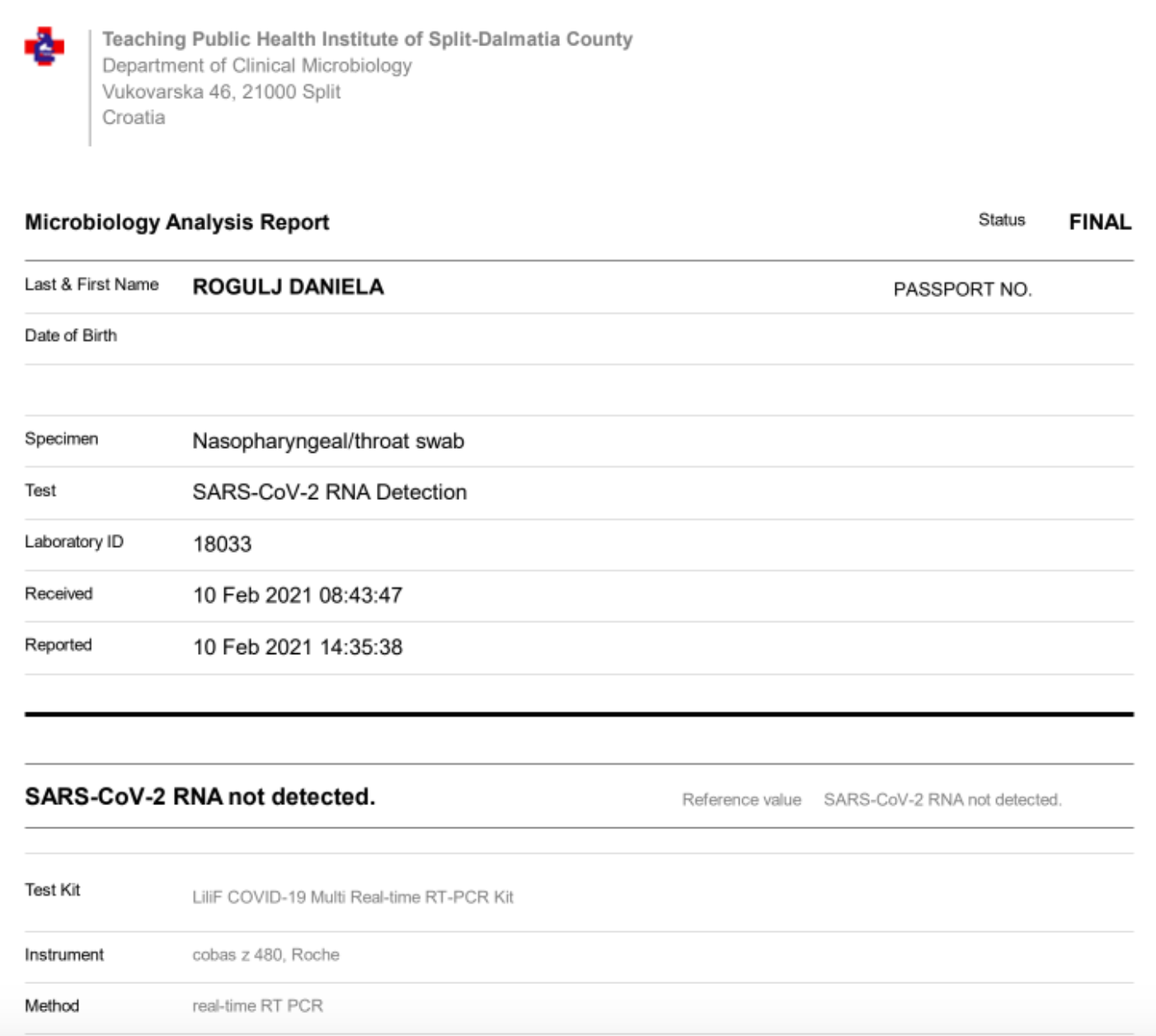
My 6:50 am flight time to Zagreb had me awake at 4 am to make sure I had everything in order. Arriving at the airport with just over an hour to spare, the woman at the check-in counter ensured I had a negative COVID-19 test in hand and confirmed that I had completed the health registration form for Spain as I'd need the QR code to enter the country. I did.
"You're my favorite kind of traveler."
As you can imagine, Split Aiport doesn't have much going on before 6 am, especially during corona times, so I was through security and at my gate with plenty of time to spare. My flight to Zagreb was nearly full.
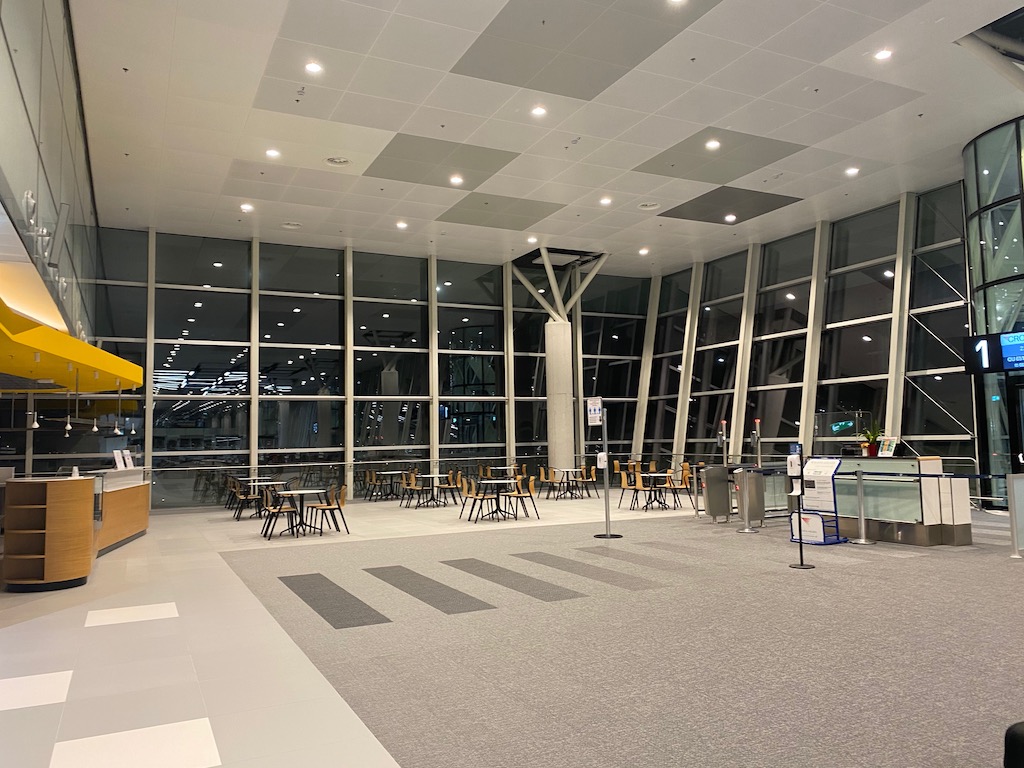
My quick connection in Zagreb had me there long enough to examine that Costa coffee was open for to-go drinks and pastries, and Duty-Free welcomed a few shoppers. Other than that, there is not much to do but stare and each other's masks while waiting to board.
Observation: Unlike when I traveled in October, the airport staff was not concerned with the type of mask passengers wore. Last time, we were only allowed disposable surgical masks, which were checked and distributed if needed before boarding. This time, cloth, filter, and disposable masks were accepted.
Croatia Airlines shared disinfectant wipes to all passengers once they boarded the flight.

My arrival in Frankfurt was smooth, and a quick trip through security brought me to my gate two hours before my departure to Spain. Frankfurt airport was busy with travelers, but only cafes, hot dog stands, and small convenience shops worked.
All that was needed when boarding for Spain was my ticket and passport - no QR code or test result was checked then, though they did announce on the intercom before boarding that both documents were required. My flight was full.
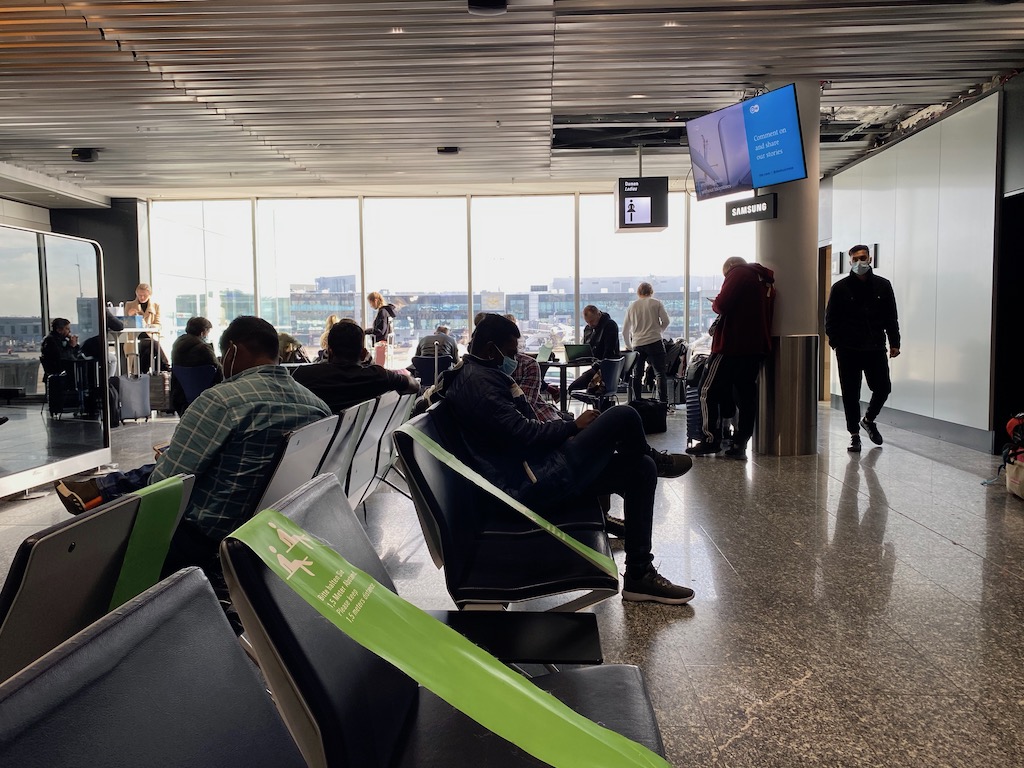
Spain changed their entry requirements in November 2020, two weeks after I visited last time.
"Spanish authorities require all passengers traveling to Spain to complete the FCS health control form (exceptions are passengers in transit). The generated QR code must be presented upon arrival. All travelers to Spain over 6 years of age must have a medical certificate with a negative COVID-19 RT-PCR or TMA test result. The test must have been taken at most 72 hours before arrival, and the certificate must be in English, German, French, or Spanish. Spanish authorities may impose fines up to EUR 6000 per person to passengers who do not comply with entry regulations," Lufthansa alerted me before my flight.
We arrived in Spain and headed to baggage claim, though not before we entered an area marked for health checks, with airport officials showing passengers to one of two lines. I was ushered into the line where my entry QR code was scanned (and no COVID-19 test checked), while the other line had various health officials checking test results and QR codes. I arrived at baggage claim 30 seconds later and received an email from Spanish health officials welcoming me to Spain.
Another thing that was different in Spain this time is that restaurants and bars are open for indoor and outdoor dining, albeit during two-time blocks - in the morning for breakfast from 7:30 am to 10:30 am and for lunch from 1 pm to 4:30 pm. While there is still a curfew between 10 pm and 6 am, delivery works until 11 pm. Barcelona closed indoor and outdoor dining a week before I arrived in October.

This was a game-changer, given that bars and restaurants have been closed for indoor and outdoor dining in Croatia since November.
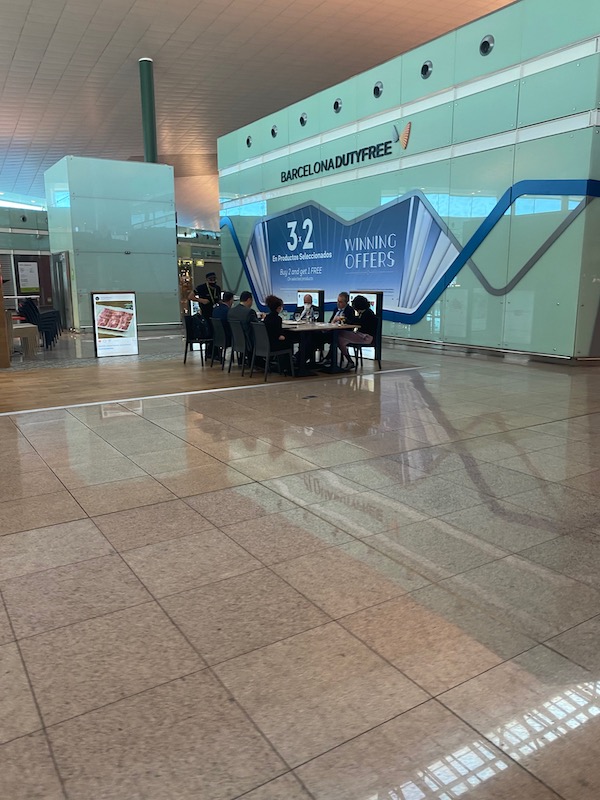
Like my last trip to Barcelona, masks are mandatory inside and outside, and it's rare to find anyone not following the rules. Shoppers sanitize their hands upon entering any store, and the discipline of the citizens does not go unnoticed.
Twenty-four hours before my flight back to Croatia, I took a PCR test at a local clinic that promised same-day results. The price was not as friendly as in Croatia (85 euro), but I wanted to ensure I was healthy returning home, especially since I would be in contact with my high-risk mother who babysat my cats while I was away.
Recall, if you do not show a negative PCR test, no older than 48 hours, upon arrival in Croatia, you are subject to self-isolation until you can show a negative PCR test, which is done at your expense. More on that here.
The testing experience in Spain was also a bit... aggressive. The nurse swabbed deep into each nostril for 10 seconds and continued to all corners of my mouth and gums, unlike the far more delicate experiences I've had in Croatia. I received my negative test result the same day, around 6 pm.
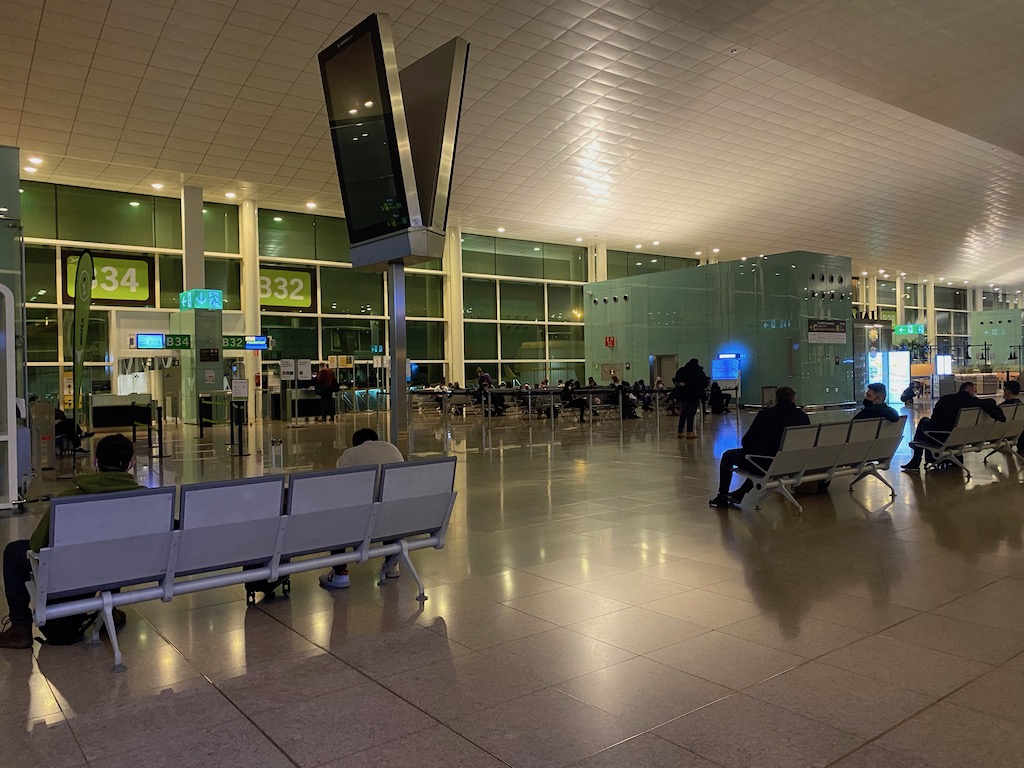
After a full four days in the Catalonian capital, it was time to return home on yet another 6 am flight and 3:30 am wake-up call. The agent at the check-in counter asked to see my negative test before checking my bag and continuing to security. My flight to Frankfurt was half full, and there was no one sitting between me and my row-mate.
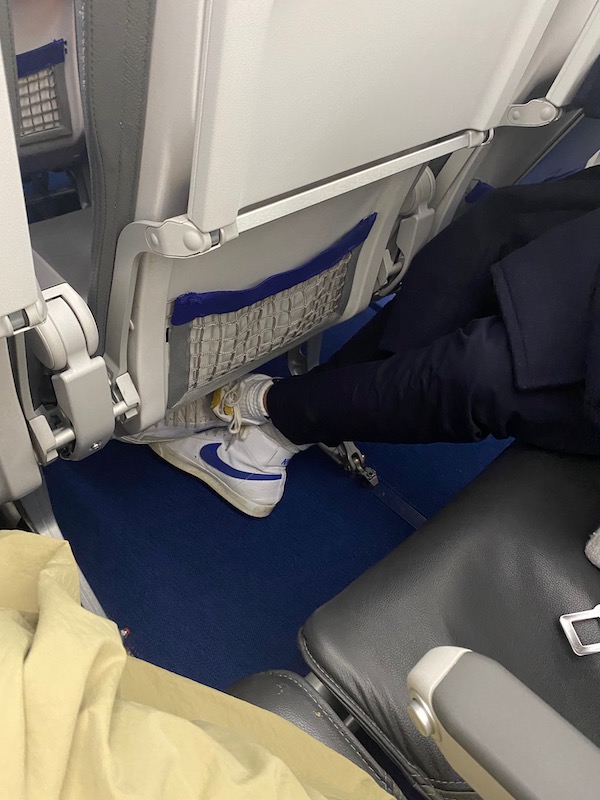
Once we disembarked the plane in Frankfurt, German police greeted us to check that passengers staying in Germany had the correct documentation. Since I was on my way to Split, they sent me along.
With a few hours to spare before my flight to Zagreb, I felt a sense of relief as I was halfway home. I went to the gate only to find passengers boarding to Seattle before us - I don't think there were more than 20 passengers on that plane.

Boarding for Zagreb was slower than normal as the buses that transported passengers from the gate to the plane arrived 20 minutes apart. There was not a free seat on the always-fun propellor plane journey to Zagreb. We were asked to fill out health forms during the flight, which the flight attendants collected and turned into the authorities once we arrived.
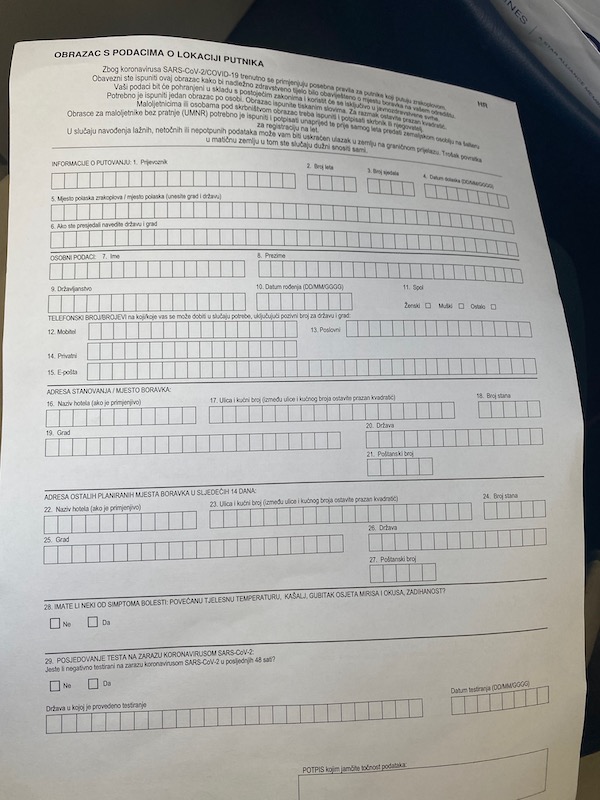
Despite leaving 10 minutes later than scheduled, we arrived in Zagreb on time, or at 1:35 pm, with just enough time for my flight to Split, departing at 2:35 pm. While this would almost always be more than enough time to connect for a domestic transfer at Zagreb Airport, especially during pandemic times, Zagreb managed the unthinkable.
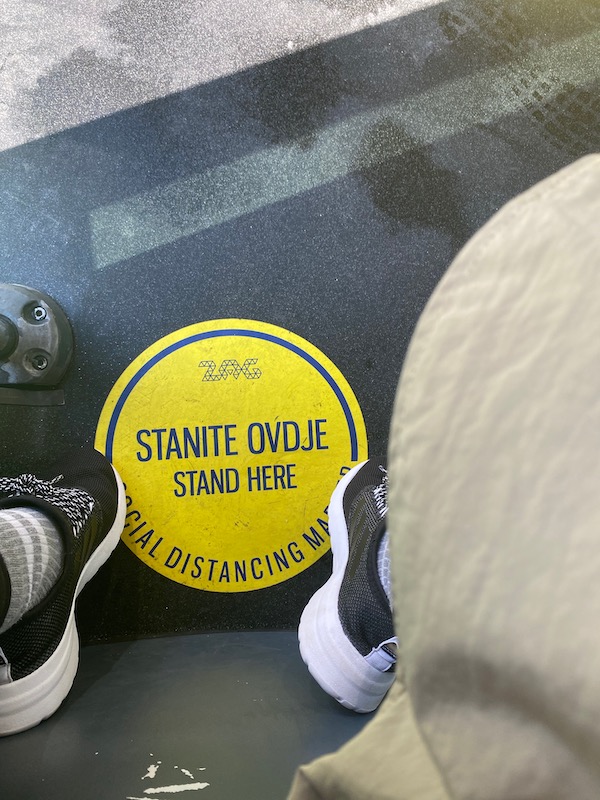
Around 25 people from my Frankfurt flight continued onto a domestic transfer, which resulted in a larger line at passport control - but only in extraordinary circumstances could this affect me making my flight, I thought.
However, only one passport control officer was on duty, spending on average 3-5 minutes with each passenger who:
1.) Didn't know they needed a negative PCR test to enter Croatia and tried avoiding mandatory self-isolation for various reasons, which resulted in phone calls, and even the arrival of a new officer, who didn't think to jump in and help check tests or documents
3.) Had the wrong type of test and complained that they didn't know they needed a PCR test to enter Croatia
4.) Had a negative PCR test to enter, which the officer required you send to his email right then and there.
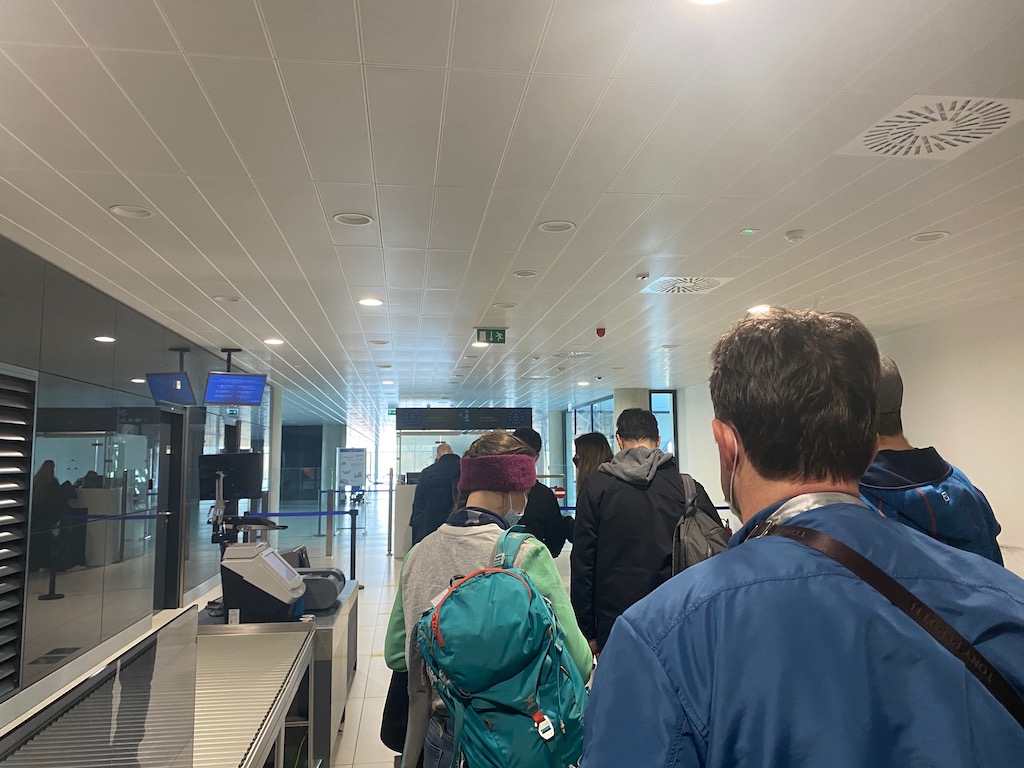
Boarding for my flight was at 2:15 pm, and around 2:00 pm, with another 15 or so still in front of me, I began to worry. Unsurprisingly, there was no one there to speak to apart from the lone worker at passport control.
At 14:18, they called final boarding for Split. I panicked, as did the 7 or so passengers behind me who were also connecting to Split. I asked the man in front of me who was traveling to Dubrovnik if I could sneak in front. I approached the counter and informed the officer they called final boarding for Split and had all of my documents and test ready to go.
He could not have cared less - nor did he hurry in the least.
He looked at my test, told me to send him an email of it, took my phone to enter the email address, and asked for my phone number. After 3 minutes, it was over, I rushed to my gate and informed them there were still others waiting at passport control, unsure of how long it would take. I finally boarded the plane, though the remaining passengers took another 15 minutes to arrive. All because of one officer at passport control.
We arrived in Split safe, sound, and somehow on time, with our bags arriving shortly after.
It was smooth sailing, that is until we arrived back in Croatia. While PCR tests no later than 48 hours old are required to avoid going into self-isolation, Zagreb Airport may want to consider adding a second officer in the passport area when flights land - or you may want to re-think the timing of your domestic transfer.
For the latest travel info, bookmark our main travel info article, which is updated daily.
Read the Croatian Travel Update in your language - now available in 24 languages.
Zagreb Reconstruction to Include Green Parks, New Car Garages and More?
February the 15th, 2021 - Is the new Zagreb reconstruction process set to include far more and be much greener than we could have imagined when the earthquake struck the capital in March last year?
As Poslovni Dnevnik writes, green development is on the way as the desire to create a proper framework for a green Zagreb reconstruction and thus a real basis for more green development aimed at the reconstruction and decarbonisation of the construction fund. All of the anove was promisingly announced by Ivica Rovis from the Institute for Physical Planning of the City of Zagreb. The institute is otherwise leading the development of a pilot project called Blok_19, which Mayor Milan Bandic should present on the anniversary of the March earthquake in Zagreb this year.
The pilot project regards a block of buildings bordering the city streets of Dalmatinska, Frankopanska, Ilica and Meduliceva, and the powers that be in the city in close cooperation with experts involved in the so-called Council for the Coordination of Activities Related to the Development of the Complete Reconstruction Programme of Zagreb's Historic Centre have been working on it for almost a year now.
The council has a president, a vice president and as many as 22 experts. The idea was to analyse all of Zagreb's blocks in this way, but considering that Block 19 has been being analysed for a year now, the question is when anything would be actually end up being restored if the entire city was taken into consideration in the same manner. In general, Block 19 should be a concretisation of the solution planned for the Gornji and Donji Grad as well as Kaptol.
The traffic study for this Zagreb reconstrution project with a primary focus on being green, as has since been found out, was made for the three previously mentioned locations, and it envisages the construction of a larger number of garages for the local population, the abolition of parking on the streets and the removal of cars from the centre.
''We'd move much more towards the opening of city blocks, which would allow pedestrians to move faster, and a larger number of bike paths would be created. Namely, after the earthquake, the government offered the citizens of Zagreb money to buy water heaters and pay for any emergency repairs, as well as a legal framework for the co-financing of any constructive Zagreb reconstruction, and the City of Zagreb has additional plans on top of that, too.
A Dalmatian-style park would make Zagreb become even greener, maybe another passage would open, two garages would find their place underground, the city's facades would become photosensitive, the buildings would be made resistant to destructive earthquakes and fully energetically renovated, traffic would be adapted and decarbonised,'' recounts Jutarnji list briefly when relaying the vision of Block 19 from one of the council members who wished to remain anonymous.
Most members of the Council don't yet want to speak publicly about what they have come up with for the green Zagreb reconstruction project because the whole thing is being kept in strict secrecy until the presentation.
For the latest travel info, bookmark our main travel info article, which is updated daily.
Read the Croatian Travel Update in your language - now available in 24 languages.
Zagreb Remains Blossoming Croatian IT Industry's Very Centre
February the 13th, 2021 - The Croatian IT industry's heart is located in Zagreb and the growth of this still blossoming sector is well known as it continues to come on leaps and bounds. Although this is in itself somewhat old news, just how advanced is Zagreb when it comes being the home to the Croatian IT industry?
As Novac/Bernard Ivezic writes, the extent to which the Croatian capital is the true heart of the Croatian IT industry has now finally been looked more deeply into as a study was conducted into precisely that. As much as four-fifths of the Croatian IT industry is located in the bustling City of Zagreb according to the latest Croatian Chamber of Commerce's IT study, which will be presented on February the 16th, 2021.
According to the study, which expands over more than 188 pages when compared to the previous such analysis of the Croatian IT industry from 2008 onwards, it is stated that IT companies located in Zagreb back in pre-pandemic in 2019 enjoyed an impressive 21.37 billion kuna in revenue, which is almost 80 percent of total Croatian IT industry revenue.
The Croatian Chamber of Commerce (HGK) and the Croatian IT industry itself has stated that the City of Zagreb is the headquarters of as many as 51 percent of all IT companies operating within the country and that 63 percent of all IT employees work there.
Opposite the City of Zagreb are two counties in which one company represents the entire IT industry there, the frequently overlooked continental areas of Bjelovar-Bilogora and Koprivnica-Krizevci County.
Goran Mrvos, president of the IT Association at the Croatian Chamber of Commerce, says that the aforementioned research was done in cooperation with Boris Zitnik from Omnia Consulting and Dalibor Suboticanc from the Research Factory.
''This year's analysis is supplemented by data on investments in research and development from the years 2008 to 2019 and offers an overview by counties for the total period, and our goal is to provide a good insight into the level of innovation and guidelines for IT industry development by IT company category,'' concluded Mrvos.
For the latest travel info, bookmark our main travel info article, which is updated daily.
Read the Croatian Travel Update in your language - now available in 24 languages.
Join the Total Croatia Travel INFO Viber community.
Flights to Croatia: TAP Portugal Plans Lisbon-Zagreb from End of March
February 11, 2021 - The latest news for flights to Croatia as TAP Portugal plans Lisbon-Zagreb from the end of March.
As we previously reported, Portuguese national airline TAP will operate on the direct line Lisbon-Zagreb from the end of March this year.
Namely, Croatian Aviation reports that the connection between the two capitals will start on the first day of the summer flight schedule (Sunday, March 28).
As a reminder, TAP Portugal connected Zagreb and Lisbon in the past, but the line was suspended in the spring of 2016. In the winter flight schedule, the flight between Zagreb and Lisbon had a stop in Bologna.
Returning to Zagreb in the spring of 2021, TAP Portugal wants to regain its position on the Croatian market, counting on Croatia Airlines not to resume traffic on its seasonal route between the two mentioned cities. Given that the Croatian national airline is unlikely to operate on this route in this year's summer flight schedule (not even in the summer of 2020), TAP Portugal will not have direct competition on the route between the capitals of Portugal and Croatia.
Three flights a week have been announced, on Wednesdays, Fridays, and Sundays, with afternoon departures from Zagreb Airport. On all flights to Zagreb, A320 aircraft (previously planned and smaller A319) with a capacity of 174 passengers have been announced.
More than 32,000 seats between Lisbon and Zagreb available for sale in the summer season of 2021.
On a planned 94 return flights in the summer flight schedule, TAP Portugal will offer more than 32,700 seats between the two cities.
In addition to passengers who can choose the direct line between Zagreb and Lisbon, TAP Portugal is counting on a larger number of transfer passengers, primarily from the United States, who will have an excellent connection to and from Zagreb with the introduction of this line.
This is a very welcome return of another large airline to Zagreb Airport, which has not been present at Croatian airports for almost 5 years. It is currently possible to buy return tickets on this line for less than 130 euros.
For the latest travel info, bookmark our main travel info article, which is updated daily.
Read the Croatian Travel Update in your language - now available in 24 languages.
VIDEO: Zagreb Scooter Speeds at Over 70km/h Delivering Food
February 11, 2021 – In the capital city of Croatia, they call it fast food for a very good reason. One Zagreb scooter and its delivery driver were videoed doing incredible speeds of over 70km/h on one of their runs.
In the capital city of Croatia, they call it fast food for a very good reason. But not everyone knew just how fast, until now. One Zagreb scooter and its delivery driver were videoed doing incredible speeds of over 70km/h on a city centre dual carriageway (divided highway). Standing upright on the thin deck of the electric vehicle, the Zagreb scooter manages to keep pace with the much more powerful cars and vans that surround him on the road.
The fast-moving Zagreb scooter was caught on the dashcam of another delivery driver who was making a similar run down Slavonska avenue on 7 February. The dual carriageway is one of the busiest and fastest in Zagreb.
It's not only the pace of the Zagreb scooter which lets you know he may be carrying hot kebabs, pizza or hamburgers to a hungry household. The driver of the Zagreb scooter is wearing one of the distinctive cube-shaped backpacks worn by fast food deliverymen all over Zagreb.
The delivery driver in the car keeps his distance from the Zagreb scooter, but his dashcam records the speed at which he's travelling. Despite hitting speeds of 73km/h himself, the car driver gains no distance on the Zagreb scooter.
The video footage has been copied and posted across social media many times. In their popular article of the video on 10 February, Croatian news portal Index said they had sent an inquiry to the Zagreb police about this event, and were expecting an answer during the morning of 11 February.
While some food delivery customers may not be discontented to know the hair-raising lengths to which drivers go to make sure their food arrives hot, you suspect many more would be just as happy if the drivers travelled with the utmost caution – and at perhaps more appropriate speeds – when making their runs.


